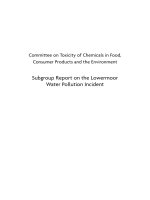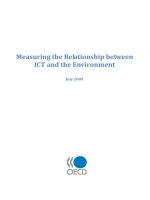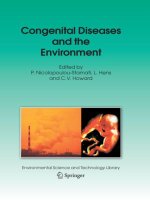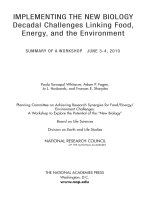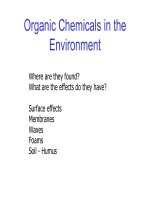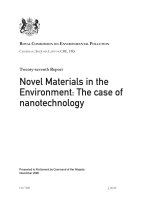Greening Your Products: Good for the environment, good for your bottom line potx
Bạn đang xem bản rút gọn của tài liệu. Xem và tải ngay bản đầy đủ của tài liệu tại đây (691.61 KB, 52 trang )
Greening Your Products:
Good for the environment, good for your bottom line
Prepared for:
Environmental Protection Agency, Office of Pollution Prevention and Toxics; (202) 260-2736
On behalf of:
• Committee for Purchase From People Who Are Blind or Severely Disabled
• National Industries for the Blind (NIB)
• NISH
Prepared by:
Tellus Institute, Boston, MA; (617) 266-5400 February 2002
Under Cooperative Agreement Numbers: C X 826825-01-0 & X 821580-01-0
Greeni
ng Your Products; US EPA, February 2002
Page
i
Acknowledgments
The information in this document has been funded wholly or in part by the United States
Environmental Protection Agency under Cooperative Agreement # C X 826825-01-0 and X
821580-01-0 to Tellus Institute. Mention of trade names or commercial products does not constitute
endorsement or recommendation for use.
The authors gratefully acknowledge Eun-Sook Goidel, EPA Project Manager, in the Pollution
Prevention Division, Office of Pollution Prevention and Toxics, for her continuous and substantive
contributions during all phases of this project. We also extend our gratitude to Julie Shannon,
Office of Pollution Prevention and Toxics, for her insightful comments on the final document.
This document would not have been possible without the generous donation of time and insights of
our “Green Guidance Development Team.” These colleagues include:
• Joan Smith, Committee for Purchase From People Who Are Blind or Severely Disabled,
Arlington, VA
• Michael Fuller, National Industries for the Blind, Earth City, MO
• Lou Heacock, NISH, Vienna, VA
• Ned Rupp, National Industries for the Blind, Alexandria, VA
• Jim Ross, National Industries for the Blind, Alexandria, VA
• Blaine Robinson, NISH, Vienna, VA
• Heather Davies, US Department of Interior, Washington, DC
• Derek Davis and Dan Hunt, Industries of the Blind, Inc., Greensboro, NC
• Linda Merrill, Envision, Wichita, KS
• Regis Barber, South Texas Lighthouse for the Blind, Corpus Christi, TX
• Gibson DuTerroil, The Lighthouse of Houston, Houston, TX
• James Bowen, Jr., Louisiana Association for the Blind, Shreveport, LA
• Elizabeth Lasky, The Easter Seal Society of Western Pennsylvania, Pittsburgh, PA
• Bob Jones, Eastern Carolina Vocational Center, Inc., Greenville, NC
• Robert Jones, National Center for Employment of the Disabled, El Paso, TX
• Paul Atkinson, Louise W. Eggleston Center, Inc., Norfolk, VA
• Karen Jury, Peckham Vocational Industries, Inc., Lansing, MI
Information for case studies was provided by:
• Paul Becker, Blind Industries and Services of Maryland, Baltimore, MD
• Vikki White, Signature Works, Hazelhurst, MS
• Barney Macari, Envision, Wichita, KS
• Barry Adamson, Multi-Community Diversified Services Inc., McPherson, KS
• Shelly Taylor, Louisiana Association for the Blind, Shreveport, LA
• Russell Clark, US EPA Office of Pollution Prevention and Toxics
Any remaining errors of fact or interpretation are the sole responsibility of the authors.
Greeni
ng Your Products; US EPA, February 2002
Page
ii
Table of Contents
Section 1: Introduction 1
Is There a Market for Green Products? 3
Section 2: What Is a Greener Product? 5
Overview: Greening Product Attributes 8
Overview: Greening the Manufacturing Process 10
Section 3: Greening Product Attributes 12
Step 1: Review guidelines 13
Step 2: Identify Greener Materials 22
Step 3: Identify Other Product Design Improvements 27
Step 4: Market your Green Product 29
Section 4:Greening the Manufacturing Process 36
Step 1: Map Your Processes 38
Step 2: Identify Greener Manufacturing Opportunities 40
Step 3: Evaluate Profitability 42
Step 4: Strive for Continuous Improvement 43
Section 5: Conclusion 45
Greeni
ng Your Products; US EPA, February 2002
Page
iii
List of Figures
Figure 1 Product and Process Approaches to Greening 1
Figure 2 Incorporate Greening into All Development Phases of a Product 2
Figure 3 Characteristics of Environmentally Preferable Purchasing 7
Figure 4 Life-cycle Diagram for Paper 8
Figure 5 Product Approach to Greening 12
Figure 6 Sample CPG Guideline— Commercial/Industrial Sanitary Tissue Products 15
Figure 7 Materials Inventory Sheet 22
Figure 8 Steps in Greening the Manufacturing Process 37
Figure 9 Lithographic Printing Process Map Example: Product Flow 39
Figure 10 Lithographic Printing Process Map Detail: Input/Loss 39
Figure 11 The Continuous Improvement Cycle 43
Figure 12 Example of Incremental Improvements 45
Greeni
ng Your Products; US EPA, February 2002
Page
iv
List of Tables
Table 1 Greening is Profitable 2
Table 2 Recent Federal Green Procurement Mandates 3
Table 3 States, Counties, and Cities Implementing EPP Programs 4
Table 4 Examples of Greener Products 5
Table 5 Two Approaches to Greening 6
Table 6 Characteristics of Greener Manufacturing 10
Table 7 Guidelines at a Glance 13
Table 8 Current List of Products With CPG Requirements 16
Table 9 Current List of Available Green Seal Standards 17
Table 10 Five Guiding Principles for Environmentally Preferable Purchasing 20
Table 11 Overview of Greener Materials 24
Table 12 Green Seal Certification Procedure 30
Table 13 Examples of Attributes That Have Been Certified By Scientific Certification
Systems (SCS) 31
Table 14 Scientific Certification Systems (SCS): Certification Procedure 31
Table 15 EPA’s CPG Program 32
Greeni
ng Your Products; US EPA, February 2002
Page
v
List of Case Studies
Recycled Writing Tablet (Blind Industries and Services of Maryland) 6
Greening Plastic Flatware (Signature Works) 9
Printing Green – Small Changes, Big Dividends (Custom Print) 11
Recycled Trash Bags (Envision, Inc.) 25
Biodegradable, Biobased Plastic Bags (Multi-Community Diversified Services Inc.;
MCDS) 26
Green Copy Paper (Louisiana Association for the Blind) 35
Greening Your Products; US EPA, February 2002 Page 1
Section 1: Introduction
Many innovative businesses have successfully introduced "green" products in recent years.
While many of these products have saved money, they have also reduced impacts on human
health and the environment by using recycled or recyclable material (e.g., recycled paper
products), reducing their energy usage (e.g., efficient washing machines that use less water and
energy) or eliminating the use of toxic chemicals during their manufacture, for example. How do
these business owners and product designers go about improving existing products or
introducing new green products? What motivates them to do so? In providing insight into these
questions, this guidance document aims to encourage you to identify opportunities to green your
existing products or introduce new green products to your product line.
This guidance document focuses on opportunities to help your business reduce the impact on the
environment, while saving you money. Two approaches for improvement are product
improvement and process improvement (Figure 1).
Figure 1 Product and Process Approaches to Greening
PRODUCT PROCESS
APPROACH
Develop products that have preferable
environmental attributes when
compared with similar products (e.g.,
use recycled materials, are energy
efficient, are easily recycled) and
market these products as green.
APPROACH
Improve your manufacturing and
business operations to reduce your
use of energy and materials as well
as reduce wastes and emissions
associated with the process of
making the product.
Greening Your Products; US EPA, February 2002 Page 2
The goal for these two approaches is to benefit your bottom line, while also benefiting the
environment. They aim to improve your profitability in a variety of ways, as shown in the table
below.
Table 1 Greening is Profitable
Increasing market share
Attracting green consumers by getting your products included in
environmentally preferable purchasing programs.
Reducing operating
costs
Increasing efficiency and reducing waste leads to better profit
margins.
Less tangible benefits
Includes benefits such as increasing employee participation and
morale, strengthening the company’s image in the community.
It is helpful to consider the product development process
(Figure 2) when considering how to incorporate greening
concepts. While greening concepts should be incorporated
into all product development phases, special consideration should be given to the product’s
design – studies show that about 70% of a product’s environmental impacts are determined by
decisions made during the design stage.
Figure 2 Incorporate Greening into All Development Phases of a Product
Concept Design Prototype
Market Manufacture Package
Phase 1:
Phase 2: Deliver
GREENING
It is important to remember that the concept of “greening” is relatively new, and is therefore still
a moving target. Government agencies and businesses alike are struggling to determine the best
ways to improve their products to better protect human health and the
environment. For example, greener materials not available today may be
available tomorrow. Thus, greening is a continuous process, as new
information and ideas become available to further improve your products and manufacturing
processes. Therefore, identifying greening opportunities should be part of the standard product
and process improvement practices of your organization.
Incorporate greening concepts into
your product development process.
Greening is a
continuous process!
Greening Your Products; US EPA, February 2002 Page 3
Is There a Market for Green Products?
Federal agencies have been purchasing green products for
quite some time, and are under increasing pressure to buy
more of these products. As early as 1976, the Resource
Conservation and Recovery Act directed federal agencies to
buy recycled-content products. More recently, various
Executive Orders as well as the Federal Acquisition
Regulation (FAR) have expanded the environmental criteria required in making purchasing
decisions (Table 2).
Table 2 Recent Federal Green Procurement Mandates
Executive Order 13101 Greening the Government Through Waste Prevention,
Recycling, and Federal Acquisition
This Order requires federal agencies to consider environmental criteria in their purchasing decisions,
states a preference for procuring "environmentally preferable" products and services, and directs the U.S.
Environmental Protection Agency (EPA) to develop guidance for environmentally preferable purchasing
(EPP).
For more information see:
Federal Acquisition Regulations
These are the rules governing how federal agencies buy goods and services. These regulations
specifically require federal agencies to "implement cost-effective contracting preference programs
favoring the acquisition of environmentally preferable and energy-efficient products and services" (FAR
23.704a).
For more information see:
Biomass Research and Development Act of 2000
This Act promotes the development and manufacture of biobased products.
For more information see:
Each year the federal government
procures more than $200 billion
worth of products and services,
giving these mandates the ability to
significantly expand the market for
green products.
Greening Your Products; US EPA, February 2002 Page 4
In addition, an estimated $400 billion is spent annually by state and local governments to
procure products and services. A growing number of state and local governments are
implementing environmentally preferable purchasing programs, including those shown below.
Table 3 States, Counties, and Cities Implementing EPP Programs
States
Connecticut, Delaware, Indiana, Maine, Maryland, Massachusetts, Pennsylvania,
Texas, Vermont, Washington DC, Wisconsin
Counties
California: Orange County, San Diego County
Florida: Lee County
Michigan: Kalamazoo County, Washtenaw County
Minnesota: Olmstead County
Missouri: Jackson County
Nevada: Washoe County
New Jersey: Cape May County
North Carolina: Chatham County
Oregon: Multnomah County
Virginia: Fairfax County
Washington: King County
Cities
Arizona: Phoenix
California: Chula Vista, Oakland, Richmond, San Diego, San Francisco, Santa
Barbara, Santa Monica
Colorado: Boulder
Illinois: Chicago
Missouri: Kansas City
New York: New York City
Ohio: Cincinnati, Dayton
Oregon: Portland
Tennessee: Chattanooga
Washington: Seattle
The above list will expand over time as more governments see the value in implementing greener
procurement systems and learn from each other. As these procurement systems grow and become
more integrated into standard practice, opportunities to successfully market your green products
will be greatly enhanced.
Resource: Information About State and Local Governments
State and Local Government Pioneers: How State and Local Governments Are
Implementing
Environmentally Preferable Purchasing Practices. November, 2000.
Greening Your Products; US EPA, February 2002 Page 5
Section 2:
What Is a Greener Product?
“Greener” products have a lesser or reduced impact on human health and the environment than
other products that perform a similar function. Table 4 compares several traditional products to
greener products.
Table 4 Examples of Greener Products
Product
Category
Traditional Product Greener Product
Improved
Environmental
Performance
Lighting
Incandescent bulb Fluorescent bulb Less energy used
Paper tablet
100% virgin paper 50% postconsumer paper
Reduces natural resource
use
Copier paper
Chlorine bleached paper Processed chlorine free paper Reduces toxic emissions
Evaluating greener products generally requires a review of multiple environmental attributes.
For example, in the above lighting example, while fluorescent bulbs use less energy than
incandescent bulbs, these bulbs contain mercury that can be released into the environment if they
are not properly disposed (e.g., not recycled).
Resource:
Evaluating Multiple Environmental Attributes
This multimedia training tool provides an overview of the US EPA’s Environmentally Preferable
Purchasing program (EPP). Section IV: Environmental Performance Characteristics provides guidance
on evaluating products across multiple environmental attributes.
Greening Your Products; US EPA, February 2002 Page 6
Traditionally, product design takes into account standard product attributes such as price,
performance, and safety. To be competitive in the marketplace, green products must incorporate
these traditional attributes. EPA’s Environmentally Preferable Purchasing (EPP) program builds
upon these traditional attributes by adding “Environment” and “Health” considerations into these
traditional building blocks (Figure 3 on the next page).
This document focuses on two approaches for greening your products: greening the attributes of
your products, and greening your manufacturing process (see Table 5). These two greening
approaches are introduced below and then explained in greater detail in Sections 3 and 4 of this
document.
Table 5 Two Approaches to Greening
Type of Greening Examples
Greening product
attributes
• Paper made from recycled content
• Flatware that is biodegradable
Greening the
manufacturing process
• Replacing traditional solvents with citrus-based solvents
• Installing energy efficient motors
Case Study:
Recycled Writing Tablet
(Blind Industries and Services of Maryland)
100% recycled, 100% postconsumer, processed chlorine free writing tablet
Blind Indust
ries and Services of Maryland (BISM) manufactures an extensive line of writing tablets. The
Department of the Interior (DOI) approached BISM a couple of years ago about developing a writing
tablet made from 100% recycled, 100% postconsumer, processed chlorine
free paper. BISM agreed and
collaborated with DOI to bring the product to market. DOI identified a vendor for the feedstock. As the
feedstock did not require any changes to BISM’s manufacturing process, the new feedstock was easily
incorporated into
the new product. Introduced less than a year ago, the new tablets cost about 20%
more than the standard 30% recycled content tablets. Sales remain slow, but BISM is confident that just
as with 30% recycled content paper, over time, product demand and prod
uction volume will increase,
causing prices to drop and increasing the product’s competitiveness.
Contact:
Paul Becker, Director of Marketing
Blind Industries and Services of Maryland
800-647-2468
Greening Your Products; US EPA, February 2002 Page 7
Figure 3 Characteristics of Environmentally Preferable Purchasing
ENVIRONMENTALLY
PREFERABLE PURCHASING
TRADITIONAL
Maintain consistency with traditional purchasing
factors (e.g., safety, price, performance)
ENVIRONMENT HEALTH
Minimize adverse health
effects (e.g., minimize
hazardous materials)
Maximize beneficial
environmental attributes (e.g.,
maximize recycled material
content)
Greening Your Products; US EPA, February 2002 Page 8
Overview: Greening Product Attributes
A product can be considered greener based on its characteristics, or “attributes.” Those attributes
can reduce the environmental impact of a product in a variety of ways. Examining a product’s
life cycle across its many stages provides a useful framework for thinking about how product
changes will impact the environment. The diagram in Figure 4 below illustrates product
attributes that can be improved for each life cycle stage, using paper manufacturing as an
example.
Figure 4 Life-cycle Diagram for Paper
Focus is usually placed on the environmental impacts arising from manufacturing. But it is also
important to consider the upstream impacts (those that occur before the product is manufactured,
such as mining or processing the input materials) and downstream impacts (after manufacture
including distribution, use, and final disposal) of a product. When thinking of ways to improve a
product’s environmental effects, think about all stages of the product’s life cycle. More detail on
greening product attributes is provided later in this document.
RESOURCE
EXTRACTION
MANUFACTURE
PACKAGING/
DISTRIBUTION
USE
FINAL
DISPOSITION
Paper made with recycled fibers reduces the
number of trees extracted and therefore
reduces the impact on forests
Manufacturing paper with an alternative
bleaching agent, such as hydrogen peroxide,
helps to minimize paper’s environmental
impacts.
Paper packaging used around reams of paper
can be made out of recyclable material
Making double-sided copies rather than
single-sided copies uses less paper.
Recycling paper after use is preferable to
disposing of it in a landfill.
LIFE-CYCLE STAGE EXAMPLE
UP-STREAMDOWN-STREAM
Greening the
manufacturing
process
Greening Your Products; US EPA, February 2002 Page 9
Case Study:
Greening Plastic Fla
tware
(Signature Works)
Signature Works, a division of LC Industries Inc., is a nonprofit company located in Hazelhurst,
Mississippi that is affiliated with the National Industries for the Blind. Signature Works began work on a
greener product to avoid th
e cost of large capital investments. These steps look likely to succeed in both
avoiding costs and in ensuring the continuity and stability of their customer base.
Signature Works, a participant in the JWOD program, is the designated mandatory source to t
he
government for plastic flatware (spoons, forks, knives etc.). Indeed, it is the principal supplier of plastic
flatware to the armed forces and was commended by the U.S. Military for the quality of their supply
support during the Gulf War. The division h
as approximately 500 employees and annual revenues of
$25 million.
In February of 2000, the Defense Logistics Agency (DLA) announced that it intended to replace flatware
made of polystyrene plastic with biodegradable and biobased alternatives and issued n
ew descriptions
and stock numbers for those items. To maintain its customer base and sole source position, Signature
Works needed to radically modify its product and possibly its production process. For some businesses,
making the changes might have genera
ted a panicked rush. Signature Works, however, was not
worried—the company was already working to develop a biobased biodegradable product.
Signature Works began assisting with the development of biobased and biod
egradable plastic flatware
in 1990, a decade earlier, when a supplier asked them to try using a resin made out of potato starch.
Although that product proved unsuccessful for technical reasons, Signature Works realized that
commercially viable biobased an
d biodegradable resins would ultimately be developed. If the company
did not play an active role in the development of those resins, the resins that emerged as commercial
products might well be incompatible with the company’s manufacturing equipment. Rep
lacing all of that
equipment would be an expensive prospect—
costing between $500,000 and $1,000,000. To avoid this
eventuality the company sought out collaborations with Natick Army Research Center, polymer
researchers, and resin suppliers, offering free u
se of its manufacturing facilities to test new and
experimental resins.
Signature Works is currently testing various biobased and biodegradable resins. As of the end of 2001,
resins tested thus far have been incompatible with Signature Works’ equipment.
However, the company
will continue identifying and testing additional resins so as to maintain their supplier relationship to the
US military.
Contact:
Vikki White
Signature Works
800-647-2468
Greening Your Products; US EPA, February 2002 Page 10
Overview: Greening the Manufacturing Process
Products can also be made greener by improving the manufacturing processes involved in
producing them. Several key characteristics of greener manufacturing are highlighted below.
Table 6 Characteristics of Greener Manufacturing
Consumes less natural resources
Requires less energy to produce
Releases less gases that lead to global climate change
Uses and releases less toxic materials
Creates less waste (both hazardous and non-hazardous)
Some aspects of greener manufacturing translate into a product attribute (e.g., paper made with
chlorine-free bleaching process). Many lead to cost savings through more efficient materials use,
waste reduction and energy use reduction.
Greening the manufacturing process also has positive impacts on human health of employees as
well as the surrounding community. For example, traditional wall paints
contain solvents, many of which are volatile organic compounds (VOCs.)
VOCs emitted while manufacturing or using the product can contribute to
the formation of ground-level ozone, a lung irritant that makes breathing difficult. Some paint
solvents can also cause lung irritation in workers manufacturing or using paints. The paint
manufacturing process can be made greener by reducing solvent use (i.e., by using solvents more
efficiently in the manufacturing process) or by replacing the solvents with those that are less
volatile and toxic.
Greening is good
for employees.
Greening Your Products; US EPA, February 2002 Page 11
Case Study:
Printing Green
–
Small C
hanges, Big Dividends
(Custom Print)
Custom Print is a sheetfed, offset lithographic printer of commercial color products including brochures,
folders, and booklets. They are a 22 year-old company employing 30 people with $4 million in annual
sales. For them, greening their process has been a profitable experience that took place by implementing
small changes over the course of a few years. The following highlights several of their initiatives and
resulting cost savings:
1. Streamlining inventory: As a result of process mapping (further described in Section 4), Custom Print
examined its inventory and purchasing records, revealing that over 80 different chemicals were on-site. A
team of press operators, purchasing staff and maintenance personnel investigating the causes for the
large inventory suggested ways for reducing the chemical inventory. First, the team discovered that
sometimes multiple chemicals were being purchased to perform the same task. Employees using these
chemicals got together to agree upon one chemical that would be used for the task. Second, the team
identified chemicals that could perform multiple tasks as a means to further reduce inventory. Lastly, the
team recommended returning unused or partially used samples to vendors. After implementing these
changes, Custom Print cut its inventory by 70% – to just 24 chemicals – and is saving an estimated
$5,000 per year in inventory and waste disposal for expired chemicals, while reducing its potential liability.
2. Modifying ventilation: After an employee complained of headaches from isopropyl alcohol (IPA) in the
fountain solution, Custom Print installed an air conditioning system with a high volume fan. A year later the
company switched to an alcohol-free system, but the fan kept running until some time later when an
employee accidentally turned it off. This accidental flip of the switch made the company realize that less
air movement was needed in the shop with the new fountain solution. The change in ventilation proved to
be very profitable – reduced air conditioning needs cut electricity costs by $2000/month (40%) and
enabled the company to renegotiate its service contract, saving $200/month. Heat from the presses was
now enough to keep the room warm in winter, cutting fuel costs by $400/year. The slower air circulation
also improved the consistency of print quality by keeping temperature and humidity more constant.
3. Reducing wasted ink: Custom Print was wasting ink because less frequently used colors often
expired before they could be consumed. Working with its ink vendor, the company reduced wasted ink by
training employees to mix specialty colors from existing ink stocks.
Initiative Annual Cost Savings
Streamlining inventory $5,000
Modified ventilation $26,800
Reduced wasted ink $8,000
TOTAL:
Approximately $40,000 per year in savings
Custom Print’s experience demonstrates that:
• Greening can improve your bottom line
• Greening often means improving process or operational changes unrelated to product manufacture
• Greening includes changes in general non-industry specific infrastructure and services, such as
heating and cooling
• Employees can help make improvements if given the opportunity
Source: US EPA Design for Environment Program, Lithography Project Case Study 2: Pollution
Prevention at Custom Print, EPA-744-F-96-001, Aug. 1996.
Contact:
Stu McMichael, President, Custom Print
703
-
979
-
6670
Greening Your Products; US EPA, February 2002 Page 12
Section 3:
Greening Product Attributes
The most common approach to greening a product is improving one or more of its environmental
attributes. Green products are oftentimes benchmarked in comparison to other products that
perform the same function. For example, you can benchmark the recycled
content of your paper products based upon (1) the average recycled paper
content currently found in the marketplace; (2) guidelines (described below)
specifying recommended recycled content; or (3) recycled content levels
found in other paper products marketed as green. All three benchmarks can provide a recycled
content target for your products.
The figure below summarizes the steps toward greening a product by improving its attributes.
Each step is subsequently detailed in this section.
Figure 5 Product Approach to Greening
1
Review Guidelines
• Comprehensive Procurement Guidelines (CPG)
• Green Seal
• Environmentally Preferable Purchasing (EPP)
2
Identify Greener Materials
• Create a materials inventory
• Get ideas for green products
3
Identify Other Product Design Improvements
• Packaging and delivery
• Design for environment (e.g., durability, repairability, upgradability, recyclability)
4
Market Your Green Product
• Certification
• Placement into green procurement systems
• Green labeling
• Marketing
Benchmark your
green products.
Greening Your Products; US EPA, February 2002 Page 13
Step 1: Review guidelines
A growing number of guidelines are becoming available to help purchasers select green products
(Table 7). These guidelines can help you find the criteria your customers may use, help you
develop criteria for greening your existing products, or provide ideas for new green products to
introduce in your product line.
Table 7 Guidelines at a Glance
Detailed on page 14 Comprehensive Procurement Guideline (CPG)
Sponsoring Organization: U.S. Environmental Protection Agency
Key component: Contains a list of designated products (and manufacturers) and
accompanying recycled content recommendations.
Website:
Detailed on page 17 Green Seal
Sponsoring Organization: Nonprofit environmental labeling organization
Key component: Provides a set of environmental criteria for products and certifies that a
particular product meets these standards.
Website:
Detailed on page 19 Environmentally Preferable Purchasing (EPP)
Sponsoring Organization: U.S. Environmental Protection Agency
Key component: The document “EPA’s Final Guidance on Environmentally Preferable
Purchasing” helps Executive agencies integrate environmental
considerations into their buying decisions.
Website:
Greening Your Products; US EPA, February 2002 Page 14
Comprehensive Procurement Guideline (CPG)
The federal government has undertaken various initiatives to
include the environment in purchasing decisions. The
Comprehensive Procurement Guideline (CPG) program is
part of EPA's continuing effort to promote the use of
materials recovered from solid waste. Buying recycled-
content products ensures that the materials collected in
recycling programs will be used again in the manufacture of
new products.
EPA is required to designate products that are or can be made with recovered materials, and to
recommend practices for buying these products. Once a product is designated, procuring
agencies (federal, state, or local agency using federal funds for procurement) are required to
purchase the product with the highest recovered material content level practicable.
Q: What is the difference between post-consumer and recovered
materials?
A: ] Post-consumer material means a material or finished product that has served its
intended use and has been diverted or recovered from waste destined for disposal,
after having completed its life as a consumer item.
] Preconsumer material means waste material that is generated from, and
commonly reused within, an original manufacturing process.
] Recovered material means both post-consumer and preconsumer materials.
The CPG program is autho
rized by
Congress under Section 6002 of the
Resource Conservation and Recovery
Act (RCRA) and Executive Order
13101 (“Greening the Government
Through Waste Prevention, Recycling,
and Federal Acquisition,” signed into
law in 1998).
Greening Your Products; US EPA, February 2002 Page 15
A key component of the CPG program is EPA's list of designated products and recommended
recycled content for each product. EPA has already designated or is proposing to designate the
products listed in Table 8 (about 54 products). EPA also published final or proposed recycled
content recommendations for each item. The CPG web site contains a brief description for each
of the designated products, EPA's recommended recycled content ranges, and a list identifying
manufacturers, vendors, and suppliers for each item. An example of a CPG guideline entry is
shown in Figure 6.
Figure 6 Sample CPG Guideline— Commercial/Industrial Sanitary Tissue Products
EPA's Recommended Recovered Fiber Content Level
Item Post-consumer
Fiber (%)
Recovered
Fiber (%)
Bathroom tissue 20-60 20-100
Paper towels 40-60 40-100
Paper napkins 30-60 30-100
Facial tissue 10-15 10-100
General purpose
industrial wipers
40 40-100
NOTE: The content levels should be read as X% recovered
fiber, including Y% post-consumer fiber and not as X%
recovered fiber plus Y% post -consumer fiber.
List of Manufacturers and Suppliers
[There are 40 entries in this list;
the following is a sample entry]
Javits-Wagner-O'Day Program
c/o National Industries for the Blind (NIB)/NISH
1901 North Beauregard Street; Alexandria, VA 22311
Phone: 800 433-2304; Fax: 703 998-5416
The Javits-Wagner-O'Day (JWOD) Program is a
mandatory source for federal customers. JWOD
nonprofit agencies furnish bathroom tissue with 100
percent recovered fiber and 20 percent post-consumer
fiber content.
Greening Your Products; US EPA, February 2002 Page 16
Table 8 Current List of Products With CPG Requirements
Construction Products
· Building insulation products
· Carpet
· Carpet cushion
· Cement and concrete containing: a. Coal fly
ash; b. Ground granulated blast furnace slag
· Consolidated and reprocessed latex paint
· Floor tiles
· Flowable fill
· Laminated paperboard
· Patio blocks
· Railroad grade crossing surfaces
· Shower and restroom dividers/partitions
· Structural fiberboard
Landscaping Products
· Garden and soaker hoses
· Hydraulic mulch
· Plastic lumber landscaping timbers and posts
· Lawn and garden edging
· Compost made from yard trimmings or food
waste
Nonpaper Office Products
· Binders, clipboards, file folders, clip portfolios,
and presentation folders
· Office recycling containers
· Office waste receptacles
· Plastic desktop accessories
· Plastic envelopes
· Plastic trash bags
· Printer ribbons
· Toner cartridges
Paper and Paper Products
· Commercial/industrial sanitary tissue products
· Miscellaneous papers
· Newsprint
· Paperboard and packaging products
· Printing and writing papers
· Park and Recreation Products
· Park benches and picnic tables
· Plastic fencing
· Playground equipment
· Playground surfaces
· Running tracks
Transportation Products
· Channelizers
· Delineators
· Flexible delineators
· Parking stops
· Traffic barricades
· Traffic cones
Vehicular Products
· Engine coolants
· Re-refined lubricating oils
· Retread tires
Miscellaneous Products
· Awards and plaques
· Industrial drums
· Mats
· Pallets
· Signage
· Sorbents
· Manual-grade strapping
NOTE: Many mandatory source JWOD products already meet environmental purchasing
criteria, including: clipboards, notebooks and binders; hanging file folders; paper towels and
napkins; steno pads, pens and pencils.
Greening Your Products; US EPA, February 2002 Page 17
Green Seal
Green Seal is a nonprofit standard setting organization that awards the "Green
Seal of Approval" to products that cause less harm to the environment than
other similar products as defined by their certification standards. Green Seal
both develops environmental standards for product categories as well as
carries out the actual certification of particular products from interested
manufacturers. Table 9 lists currently available product certifications.
Before a product gets the Green Seal, it must go through a
certification process administered by Green Seal to ensure
it meets the environmental standards that Green Seal has
established. Unlike the Comprehensive Procurement
Guidelines, which do not actually certify products from
individual companies, Green Seal operates as an unbiased,
third party certification organization.
After a product is successfully certified, it is permitted to
display the Green Seal label. Having a Green Seal
certification for your product increases its visibility and
marketability.
Table 9 Current List of Available Green Seal Standards
Tissue Paper
Re-Refined Engine Oil
Compact Fluorescent Lamps
Water Efficient Fixtures
Printing and Writing Paper
Household Cleaners
Paper Towels and Paper Napkins
Coated Printing Paper
Paints
Windows
Window Films
Newsprint
Reusable Utility Bags
Refrigerators
Freezers
Clothes Washers
Clothes Dryers
Dishwashers
Cook tops/Ovens/Ranges
Watering Hoses
Alternative Fueled Vehicles
Anti-Corrosive Paints
Plastics Labeling Systems
Showerheads
Paper Products Used in the Preparation of Food
Residential Air Conditioning Systems
Fleet Vehicle Maintenance
Powdered Laundry Bleach
Electric Chillers
Residential Central Air-Source Heat Pumps
Degreasers
Food Service Packaging
Commercial Adhesives
Industrial & Institutional Cleaners
Q: What if I do not want to pursue
Green Seal Certification?
A: The certification information provided
by Green Seal is very valuable even if
you choose not to pursue certification. It
can give
you ideas of green products that
you may wish to develop, and to
understand the generally accepted green
attributes of that product.
For more information on certification, see
the section below called “Marketing Your
Product.”
Greening Your Products; US EPA, February 2002 Page 18
Example of a Green Seal Standard: Tissue Paper (GS
-
01)
Second Edition, February 12, 1992 Copyright 1992 Green Seal, Inc.
A. Product Specific Performance Requirements
1.
Product must be made in accordance with reasonable industry practice with respect to
holes, tears, wrinkles, cleanliness, foreign materials or dirt. It must have no disagreeable
odor, either wet o
r dry, in accordance with reasonable industry practice. Edges of the
product must be cleanly cut and not ragged. Product must dispense properly from dispenser
or roll.
2. Each roll of bathroom tissue must contain at least 40 square feet of product (300 x
4.5" x
4.4" sheets). Each box of facial tissue must contain at least 70 square feet of product (175 x
8.0"x 8.0" sheets).
B. Product Specific Environmental Requirements
1.
Bathroom Tissue: the fiber in bathroom tissue shall contain 100% recovered materials,
including 20% post-consumer materials.
2.
Facial Tissue: the fiber in facial tissue shall contain 100% recovered materials, including
10% post-consumer materials.
3. Post-consumer Content: the post-
consumer content of a product shall be determined by
mea
suring the average product fiber utilization over a period of no longer than three
months.
4. De-inking of Recovered Paper: recovered paper shall not be de-
inked using a solvent
containing chlorine, or any chemicals listed by the EPA under Section 313 of
the
Emergency Planning and Community Right To Know Act.
5.
Bleaching: If a bleaching agent containing chlorine is used, the adsorbable organic halogen
content of the effluent from the production facility shall not exceed 1.0 kg per air dried metric
ton of pulp. Chlorine and its derivatives shall not be used after January 1, 1996.
6.
Additional Ingredients: the product (not including packaging) shall not contain any added
pigments, inks, dyes, or fragrances.
C. Packaging Requirements
1. The core of a roll of
bathroom tissue or the box used to package facial tissue must be made
from 100% recovered fiber.
2.
A consumer package of bathroom tissue must contain at least 4 rolls unless the outer
wrapper has been manufactured from 100% recycled materials.
3. Packa
ging shall not contain inks, dyes, pigments, stabilizers, or any other additives to which
any lead, cadmium, or hexavalent chromium has been intentionally introduced.
4. The sum of the concentration levels of lead, cadmium, mercury, and hexavalent chromiu
m
present in any package or packaging components shall not exceed 100 parts per million by
weight.
D. Labeling Requirements
1. The Green Seal Certification Mark may appear on the packaging and the product itself.
2. Whenever the Certification Mark appears on a
package or product, the product or package
must contain a description of the basis for certification. The description shall be in a
location, style, and typeface that are easily readable by the consumer.
Reference:
Greening Your Products; US EPA, February 2002 Page 19
Q:
How is "environmentally preferable" defined?
A: Executive Order 13101 defines environmentally preferable as: " products or services that have a
lesser or reduced effect on human health and the environment when compared with competing products or
services that serve the same purpose. This comparison may consider raw materials acquisition, production,
manufacturing, packaging, distribution, reuse, operation, maintenance or disposal of the product or service."
Environmentally Preferable Purchasing (EPP)
The U.S. federal government is the single largest consumer of goods and services in the U.S.,
spending more than $200 billion annually on goods and services. EPA recognizes that this
tremendous purchasing power influences what products and services are produced. EPA’s
Environmentally Preferable Purchasing (EPP) program, a federal program (established pursuant
to Executive Order 13101) leverages that power by encouraging and assisting Executive agencies
in purchasing environmentally preferable products and services.
EPP’s goal is to empower federal consumers to make smart purchasing decisions that reflect
environmental considerations. Various tools developed by the program assist this goal.
On
-
line EPP Tools
Use the “General Environmentally Preferable Purchasing Training Tool.” This
Interactive Training Tool is intended to help quickly and easily understand
Environmentally Preferable Purchasing.
Additional information can be found in the document “EPA’s Final Guidance on
Environmentally Preferable Purchasing.”
Use the on-line “EPP Database” to learn more about green standards for specific
products.

